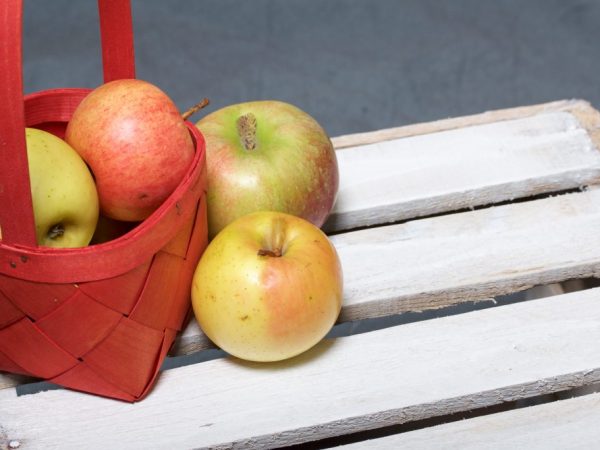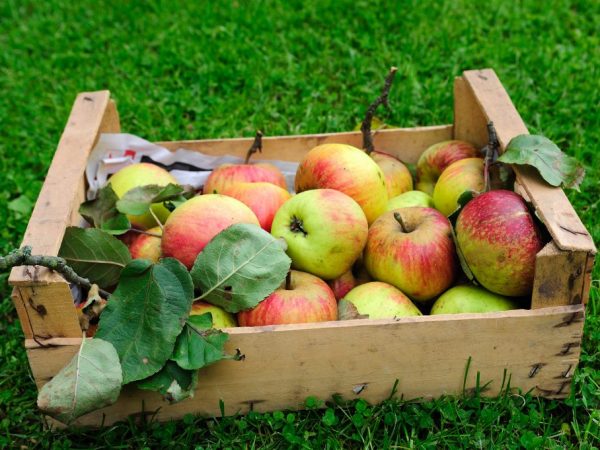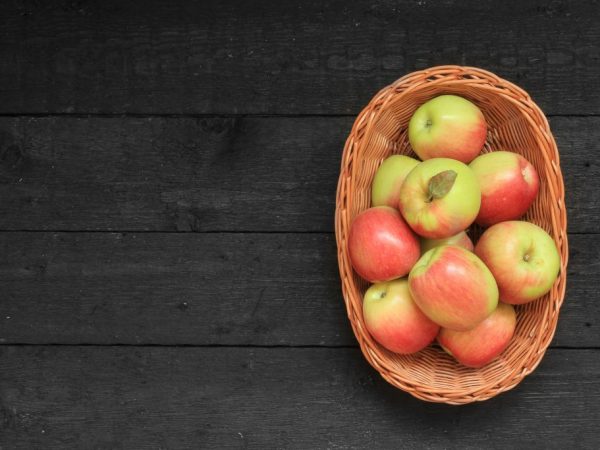Varietal features of the Korobovka apple tree
Apple tree Korobovka belongs to the early varieties. In the common people it is called Skorospelka or Medunichka. The apples are small in size but taste very sweet.

Varietal features of the Korobovka apple tree
Description
It is not customary to use this variety in horticulture, although in Poland it is included in the list of special crops valued by renowned breeders for heritable traits of excellent quality.
The tree has been bearing fruit for 50 years, which allows you to see it in old, sometimes abandoned, garden plots.
Tree and fruit
This tree has never been grown on an industrial scale, but despite this, it is very common and known throughout Belarus, the Baltic States, Ukraine and Poland.
According to its structural features, the tree belongs to powerful subspecies, its height reaches 6 m. During the first 25 years, the crown has a pyramidal shape. In the subsequent years of its life, the tree is shrouded in a crown of a spreading type.
The leaves are green, with an emerald tint, and are round in shape, dense in structure. Their edges are serrated, which is their distinctive feature.
A lot of fruits are formed on each tree. Up to 70 kg of apples can be harvested from one crop.
Taste
The pulp of the fruit is yellowish. There is practically no sourness in it. You can compare the taste of these fruits with honey. They are characterized by increased juiciness. Can be consumed even when not fully ripe.
Winter hardiness and lifespan
This variety perfectly adapts to frost. The description indicates excellent winter hardiness. The apple tree is attributed to long-livers: the life of the tree is up to 50 years.
Pollinators

Picky delicious apples
Pollination for the Korobovka apple tree is an important process. Pollination may not occur near the seedlings of the Papirovka, Cinnamon striped, White Naliv and Kitayka Saninskaya varieties. This is due to the fact that these trees cannot fully grow and develop in relative proximity to each other.
This feature of the variety must be taken into account when planting and planning the placement of trees in the garden.
Advantages and disadvantages
This apple tree has a number of advantages:
- resistance to high temperatures;
- picky about the nature of the soil;
- excellent taste of ripe apples with a honey aroma;
- no burns from the rays of the sun, which is explained by the presence of leaves of a dense structure;
- a lot of debris does not accumulate under the tree, because branches break off extremely rarely.
The disadvantages of the variety include:
- the presence of self-infertility;
- small fruits, maximum apple diameter - no more than 5 cm;
- lack of resistance to the moth.
Landing
Korobovka saplings are placed in the ground at the age of 1-2 years in early spring, with non-swollen buds. Trees that are up to 4 years old are best planted in the autumn, after the leaves have fallen off.
When planning a planting in the fall, it is necessary to prepare the soil in the spring. To do this, it is enough to add fertilizers per 1 sq. m:
- humus - 15 kg;
- sulfate - 40 g;
- superphosphate - 70 g.
It is necessary to dig up the soil no deeper than the bayonet of the shovel. When digging a hole to place a seedling in it, it is worth considering its size. The optimum depth of the pit is no more than 1 m, and the width is 1.3 m.If you plan to plant an apple orchard of the Korobovka variety, then the distance between the rows should not be less than 6 m.
Before planting, it is recommended to soak the roots with water for several hours, then mix them with ash. During this procedure, gloves must be worn to protect hands from injury.
It is necessary to plant a future fruit tree in a hole, in the middle of which a stake from a tree is inserted.
Care
It is necessary to take care of a seedling of this type regularly. Particular attention should be paid to feeding, which allows you to improve, regardless of the age of the tree, its root system and increase the yield. Correctly selected fertilizers increase resistance to sudden changes in temperature and prevent the tree from dying.
When choosing fertilizers, you should pay attention to several groups:
- mineral;
- organic;
- microbiological;
- a complex of trace elements.
The combination of the above types of top dressing will allow the tree to fully develop and bear fruit, delighting the gardener with an excellent harvest.
Do not forget about watering the seedling, which is carried out with the arrival of spring and ends in late autumn. For an apple tree that is more than 7-8 years old, it is necessary to use at least 15 liters of water within 7 days. For younger trees, only 10 liters is enough.

The apple tree bears fruit every year
Pruning and shaping the crown
Pruning is necessary in the autumn and spring. In the first case, its main goal is to remove shoots damaged in summer and weakened due to high temperatures. Otherwise, in winter, they can provoke diseases of the bacterial and fungal type.
With the onset of spring, pruning of a formative nature is carried out, which can only be carried out if the apple tree is at least 4 years old. During the procedure, it is necessary to completely remove the branches growing into the crown, damaged during snow drifts and winds.
Ripening and fruiting
At a young age, the apple tree bears a harvest every year, and its number increases annually. When the tree reaches 20 years of age, the fruitfulness decreases and you can enjoy the harvest only once during several years. Not only the number of apples is significantly reduced, but also the size of the fruits.
The first crop can be harvested only 8 years after planting, and every year it will increase significantly. Fruits in the middle of summer are fully ripe and ready to be harvested. Their shelf life is short - only a month, during which it is necessary either to eat them or to process them.
Harvesting and storage
The apple tree ripens in early August. The main feature of the variety is that the fruits do not fall to the ground, but are firmly attached to the branches. The only exceptions are those that were affected by the peduncle. The second half of the day is ideal for harvesting - the dew will have time to evaporate and the fruits will not be wet.
When collecting fruits of the Korobovka variety, it is recommended to take into account that they ripen from the south side a little earlier than from the north. Droppings, fruits with visible physical damage and a stalk should not be stored, but rather discarded immediately.
For a long shelf life, it is recommended to use boxes made of wooden material, carefully pre-treated with a light solution of manganese crystals.
Growing in different regions
You can grow an apple tree of the Korobovka variety with a good harvest in several regions:
- on the territory of the Moscow region, the variety does not require special agrotechnical measures.This is due to favorable soil and climate resources. It is enough to feed the soil in time with organic and chemical fertilizers;
- on the territory of Siberia and the Urals, the top of the tree freezes under freezing conditions, which is caused by severe frosts, but this does not affect the quantity and quality of the harvested crop;
- in the Leningrad region there is high humidity, but you can grow an apple tree. It is worth paying special attention to the occurrence of fungal and bacterial diseases and, at their first manifestations, immediately take measures to eliminate them.
Gardeners reviews
Experienced gardeners talk about the Korobovka variety with admiration, and they cannot describe the taste of the fruit in words. Many of them grow it on their own plots and do not plan to place other types of apple trees in the neighborhood.
Garden owners are not afraid of the relatively short shelf life of apples of this variety, because they make a delicious and very aromatic compote, jam and preserves. In winter, the blanks are used as filling for pies, which is a pleasure to drink tea with.

